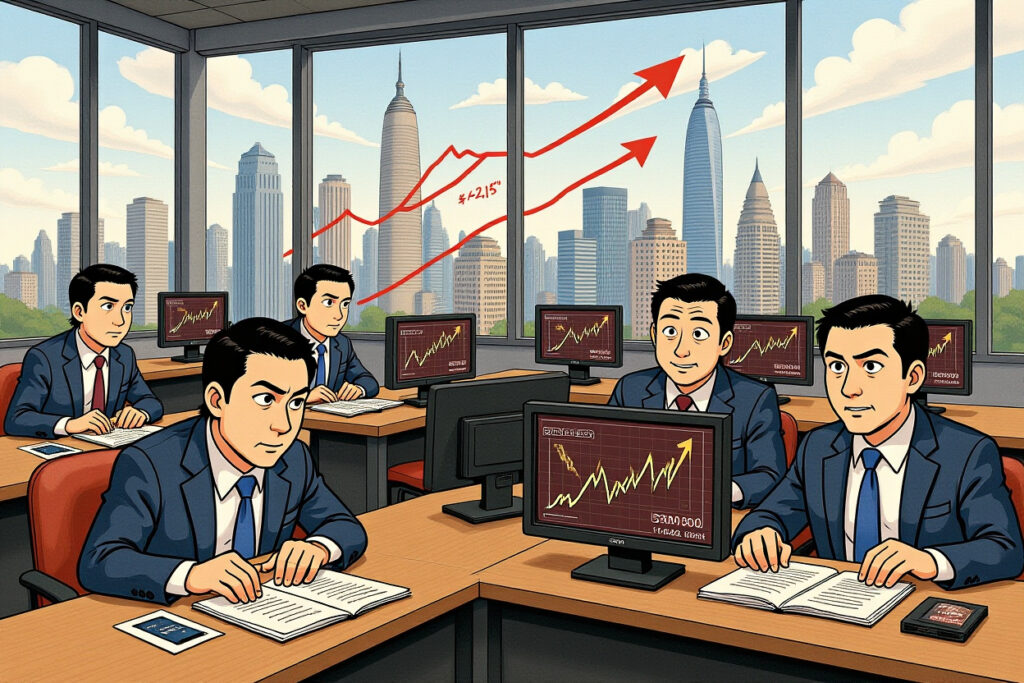The Federal Reserve’s Historic Policy Crossroads
The Federal Reserve stands at a critical juncture as conflicting economic signals create unprecedented divisions within the Federal Open Market Committee. With employment indicators flashing warning signs while tariff-related inflation pressures persist, policymakers face their most complex decision environment since the pandemic era. This convergence of opposing forces sets the stage for what could become the first three-way split vote in five years, reflecting the extraordinary challenges confronting monetary authorities.
Market participants worldwide closely monitor these developments, particularly investors with exposure to Chinese equities who understand how U.S. monetary policy reverberates through global markets. The Fed’s decision will influence capital flows, currency valuations, and risk appetite across emerging markets, making this meeting particularly significant for international portfolios with Chinese market exposure.
The Convergence of Opposing Economic Forces
Two powerful economic narratives are pulling Fed policymakers in opposite directions. On one side, deteriorating employment figures suggest the economy may need stimulus. Initial jobless claims recently reached their highest level since 2021, while the latest nonfarm payroll report showed the first monthly job losses since the COVID-19 pandemic began.
Conversely, persistent inflation concerns rooted in trade policy continue to worry hawkish committee members. The unemployment rate remains at a relatively low 4.3%, and some officials believe inflation metrics haven’t fully incorporated the impact of recent trade measures. This fundamental tension creates the conditions for a potential three-way split that would highlight the unusual pressures on the committee.
The Employment Conundrum: Weakening Labor Market Signals
Recent employment data has provided dovish committee members with compelling arguments for more aggressive easing. The labor market, long a source of economic strength, shows concerning signs of deterioration that could justify preemptive policy action.
The numbers tell a concerning story: weekly jobless claims have climbed steadily, reaching levels not seen in three years. More significantly, the economy recorded its first monthly job loss since the pandemic recovery began, suggesting underlying weakness that could accelerate without policy support.
Data Points Driving the Dovish Position
– Initial jobless claims at highest level since 2021
– First monthly job loss since COVID-19 pandemic
– Unemployment rate at 4.3% but showing upward momentum
– Multiple sectors showing hiring slowdowns
– Wage growth moderation indicating reduced labor market tightness
These developments have strengthened the case for those advocating more substantial rate cuts. Fed Governor Christopher Waller, considered a leading candidate to potentially succeed Chair Jerome Powell next year, might view this data as sufficient justification for a 50-basis-point reduction. The possibility of Stephen Miran, a Trump ally, joining the board before September’s meeting could further bolster the case for aggressive action.
Inflation Imperative: Tariff Pressures and Price Stability
While employment concerns push toward easing, inflation risks pull in the opposite direction. The Trump administration’s tariff policies have introduced persistent inflationary pressures that complicate the Fed’s dual mandate of maximum employment and price stability.
Chair Powell has characterized tariff impacts as “one-time shocks” that the Fed can look through, but regional bank presidents including Austan Goolsbee (Chicago Fed), Jeff Schmid (Kansas City Fed), and Alberto Musalem (St. Louis Fed) remain skeptical. They argue that inflation continues to climb gradually and hasn’t fully reflected trade policy impacts, making premature monetary easing risky.
The Hawkish Perspective on Price Stability
Inflation hawks point to several factors supporting their cautious approach. Core inflation measures remain above the Fed’s 2% target, with goods inflation particularly susceptible to further tariff increases. The potential for additional trade restrictions creates uncertainty about future price trajectories, suggesting the Fed should maintain higher rates for longer.
These officials note that the current unemployment rate, while rising, remains low by historical standards. With job losses only recently emerging and concentrated in specific sectors, they advocate watching for more conclusive evidence of economic deterioration before committing to significant easing.
Political Dimensions: Presidential Pressure and Institutional Independence
Beyond pure economic considerations, political factors complicate the Fed’s decision-making process. Former President Trump’s persistent criticism of Chair Powell and attempts to influence monetary policy create additional challenges for the central bank’s perceived independence.
The controversy surrounding Governor Lisa Cook and threats to her position further highlight the political pressures facing the institution. In this environment, policy decisions take on added significance as the Fed balances economic fundamentals against political realities.
Strategic Considerations for Chair Powell
Some analysts suggest that hawkish dissent might actually benefit Powell politically. Evercore ISI’s Krishna Guha notes that opposition from more conservative members could “help balance pressure from Trump and his appointees for more aggressive rate cuts.” This dynamic might allow Powell to navigate between political demands and economic necessities.
LHMeyer analyst Derek Tang speculates that Powell might attempt a “grand bargain” that trades hawkish support for current action against promises of higher thresholds for future easing. Such a compromise could prevent the appearance of capitulation to political pressure while addressing genuine economic concerns.
Forward Guidance: Reading the Dot Plot Amid Uncertainty
The Federal Reserve’s quarterly economic projections, particularly the “dot plot” illustrating committee members’ interest rate expectations, will provide crucial insight into future policy direction. The unusual economic circumstances suggest these projections may show unprecedented dispersion, reflecting the committee’s divergent views.
As former Fed official Vincent Reinhart vividly describes: “The economic projections will be the most scattered we’ve ever seen. The dot plot is like a giant blank canvas…we’re about to see a ‘splatter painting.'” This imagery captures the extraordinary uncertainty facing policymakers as they attempt to chart a course through conflicting economic signals.
Interpreting the Committee’s Divided Outlook
JPMorgan’s Michael Feroli suggests that “given the inflation situation, moderates and hawks on the committee will likely be very cautious about committing to a future easing path.” This caution will manifest in the dot plot through wider-than-usual dispersion among members’ projections, making it difficult to discern a clear policy trajectory.
Investors should pay particular attention to the range of projections rather than focusing exclusively on the median forecast. The distribution of dots will reveal the depth of division within the committee and provide clues about possible policy directions under different economic scenarios.
Investment Implications and Market Outlook
The potential for a three-way split at the Fed carries significant implications for global financial markets, particularly Chinese equities sensitive to U.S. monetary policy. Divergent voting patterns could signal increased policy uncertainty, potentially elevating volatility across asset classes.
For international investors, understanding the Fed’s internal dynamics becomes crucial for portfolio positioning. Different policy outcomes could drive substantial movements in currency markets, particularly the USD/CNY exchange rate, while influencing capital flows between developed and emerging markets.
Positioning for Policy Uncertainty
– Monitor Fed communications for clues about future policy direction
– Assess currency hedging strategies given potential USD volatility
– Review emerging market exposure, particularly Chinese equities sensitive to U.S. rates
– Consider duration positioning in fixed income portfolios
– Evaluate commodity exposures given dollar sensitivity
The unprecedented nature of this potential three-way split suggests investors should prepare for multiple scenarios rather than betting heavily on a particular outcome. Flexibility and risk management become paramount in navigating the uncertainty created by the Fed’s internal divisions.
Navigating Uncharted Monetary Waters
The Federal Reserve’s meeting represents a watershed moment for central banking in a increasingly complex global economic environment. The emergence of a three-way split would highlight the extraordinary challenges facing monetary policymakers as they balance domestic employment concerns against inflation risks exacerbated by trade policies.
For market participants, particularly those with exposure to Chinese markets, understanding these dynamics provides crucial context for investment decisions. The Fed’s actions will influence global liquidity conditions, risk appetite, and capital flows, making informed interpretation of their decisions essential for successful portfolio management.
As the economic landscape continues to evolve, maintaining flexibility while monitoring Fed communications remains the prudent approach. The potential three-way split underscores that we’ve entered a new era of monetary policy complexity requiring heightened attention to central bank dynamics and their global implications.




